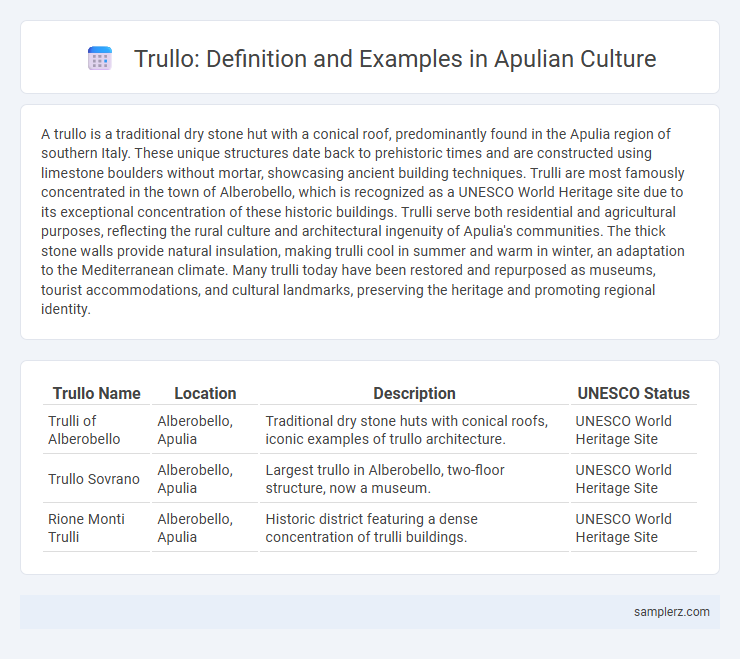A trullo is a traditional dry stone hut with a conical roof, predominantly found in the Apulia region of southern Italy. These unique structures date back to prehistoric times and are constructed using limestone boulders without mortar, showcasing ancient building techniques. Trulli are most famously concentrated in the town of Alberobello, which is recognized as a UNESCO World Heritage site due to its exceptional concentration of these historic buildings. Trulli serve both residential and agricultural purposes, reflecting the rural culture and architectural ingenuity of Apulia's communities. The thick stone walls provide natural insulation, making trulli cool in summer and warm in winter, an adaptation to the Mediterranean climate. Many trulli today have been restored and repurposed as museums, tourist accommodations, and cultural landmarks, preserving the heritage and promoting regional identity.
Table of Comparison
| Trullo Name | Location | Description | UNESCO Status |
|---|---|---|---|
| Trulli of Alberobello | Alberobello, Apulia | Traditional dry stone huts with conical roofs, iconic examples of trullo architecture. | UNESCO World Heritage Site |
| Trullo Sovrano | Alberobello, Apulia | Largest trullo in Alberobello, two-floor structure, now a museum. | UNESCO World Heritage Site |
| Rione Monti Trulli | Alberobello, Apulia | Historic district featuring a dense concentration of trulli buildings. | UNESCO World Heritage Site |
Origins and Historical Significance of Trulli in Apulia
Trulli are traditional dry-stone huts with conical roofs primarily found in Apulia, Italy, dating back to prehistoric times and uniquely constructed without mortar. Their architectural origins are linked to ancient building techniques aimed at creating durable, whitewashed rural dwellings suited to the Mediterranean climate. Recognized as UNESCO World Heritage Sites, trulli symbolize the cultural heritage and historical significance of Apulia, reflecting centuries of local craftsmanship and rural life.
Architectural Features of Trulli Homes
Trulli homes in Apulia are characterized by their conical limestone roofs constructed without mortar, utilizing a dry stone technique unique to the region. These structures feature thick, whitewashed walls that provide natural insulation, maintaining cool interiors during hot Mediterranean summers. Iconic trulli often display decorative pinnacles atop their roofs, each symbolizing different local traditions or builder signatures.
Notable Examples of Trulli in Alberobello
The trulli of Alberobello in Apulia are iconic examples of traditional limestone dwellings with conical roofs, dating back to the 14th century. These UNESCO World Heritage structures showcase unique dry-stone construction techniques without mortar, characteristic of the Itria Valley region. Notable trulli, such as Trullo Sovrano, exhibit intricate architectural details and remain a significant cultural symbol of Apulian heritage.
Trulli in Rural Apulian Landscapes
Trulli are traditional limestone dwellings characterized by conical roofs, predominantly found in the rural landscapes of Apulia, Italy, particularly in the Itria Valley. These unique structures, constructed using dry stone masonry without mortar, reflect ancient building techniques adapted to the region's geography and climate. The trulli of Alberobello, a UNESCO World Heritage Site, exemplify this distinctive architectural heritage central to Apulian cultural identity.
UNESCO World Heritage Status of Alberobello’s Trulli
Alberobello's trulli, located in Apulia, are stone huts with conical roofs that exemplify prehistoric building techniques unique to this Mediterranean region. Recognized as a UNESCO World Heritage site in 1996, these structures represent a remarkable example of vernacular architecture designed for practical living and defense. The trulli's cultural significance highlights Apulia's historical continuity and the community's adaptation to environmental conditions over centuries.
The Cultural Symbolism of Trulli in Apulian Identity
Trulli, traditional dry-stone huts with conical roofs found in Apulia, symbolize the region's architectural ingenuity and historical continuity. These unique structures represent a deep connection to Apulian rural life and cultural heritage, embodying a sense of community and identity. Recognized by UNESCO, trulli highlight Apulia's commitment to preserving its distinctive cultural landscapes.
Trullo Restoration and Preservation Efforts
The trullo, a traditional Apulian dry stone hut with conical roofs, exemplifies southern Italy's unique architectural heritage. In Apulia, focused restoration projects employ traditional materials and techniques to preserve these UNESCO-recognized structures while adapting them for modern use. Preservation efforts emphasize maintaining the trullo's original limestone composition and distinctive shape to ensure cultural continuity and promote sustainable tourism.
Trulli in Modern Apulian Tourism
Trulli, traditional Apulian dry stone huts with conical roofs, are iconic symbols of Apulia's cultural heritage and attract thousands of tourists annually. These unique dwellings, predominantly found in Alberobello, have been recognized as UNESCO World Heritage sites, boosting local tourism and economic development. Modern Apulian tourism leverages trulli architecture by integrating authentic experiences, such as guided tours and stays in restored trulli accommodations, to promote sustainable cultural tourism.
Unique Construction Techniques of Trulli
Trulli in Apulia showcase a distinctive construction method using dry stone walls without mortar, featuring conical limestone roofs built with overlapping corbelled stones. This technique ensures natural insulation and structural stability while reflecting ancient building traditions unique to the Itria Valley. The geometric precision and use of local materials highlight the cultural heritage and architectural ingenuity of the Apulian region.
Trulli-Inspired Art, Cuisine, and Local Festivals in Apulia
Trulli, the iconic conical-roofed stone houses native to Apulia, inspire a unique blend of traditional art, cuisine, and local festivals that celebrate the region's rich cultural heritage. Artists showcase trulli motifs in ceramics and paintings, while regional dishes often incorporate ingredients from Apulia's fertile land, served in rustic trullo-style settings. Annual festivals like the Alberobello White Trulli Festival highlight this architectural marvel, featuring folk music, crafts, and culinary delights that reflect centuries-old traditions.

example of "trullo" in "Apulia Infographic
 samplerz.com
samplerz.com